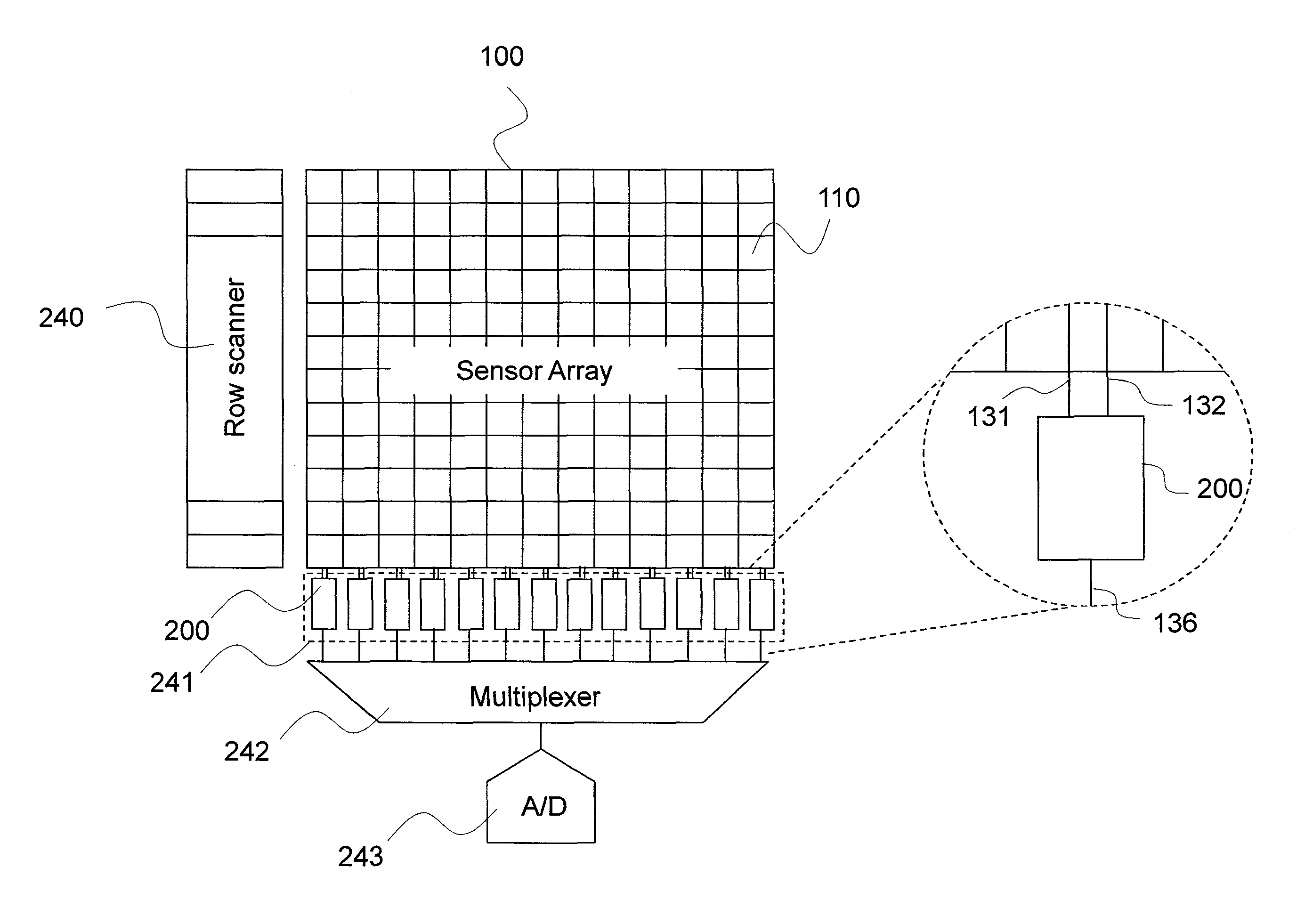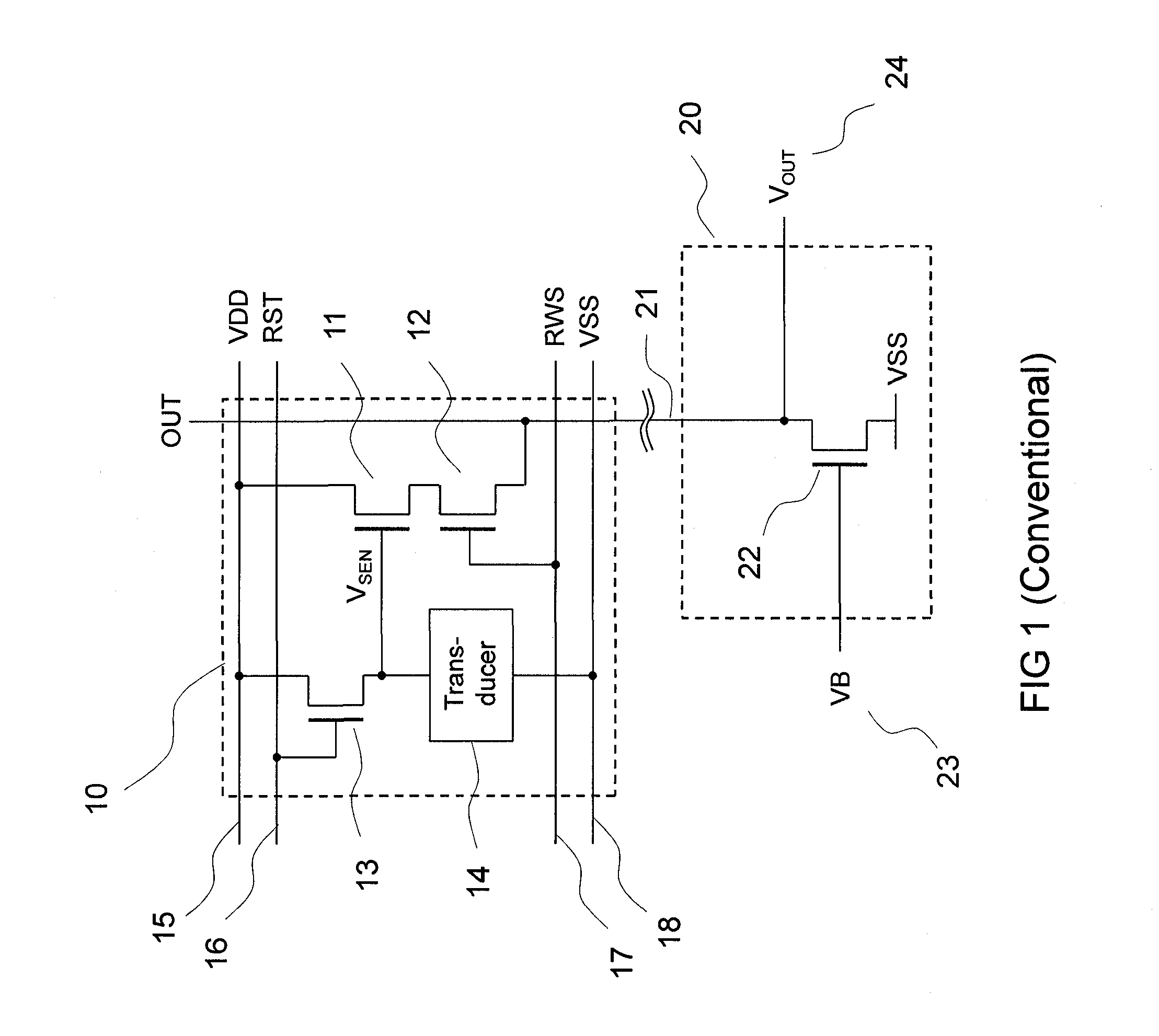Sensor array with high linearity
a sensor array and linear technology, applied in the field of large-area sensor arrays, can solve the problems of high power loss, limit the speed at which sampling operation may be performed, and high power consumption, and achieve the effects of reducing the dependence on the parasitic resistance of the signal address line, reducing power consumption, and stable bias voltag
- Summary
- Abstract
- Description
- Claims
- Application Information
AI Technical Summary
Benefits of technology
Problems solved by technology
Method used
Image
Examples
first embodiment
[0222]The operation cycle of a one-transistor active pixel sensor circuit 300 is well-known and is now described only in summary. In a manner similar to the operation of the active pixel sensor circuit 110 of the first embodiment, during the first and second stage of the operation cycle (Periods 1 and 2) the active pixel sensor circuit 110 is reset and the physical signal to be measured is converted into a voltage signal, VSEN. Then, in the third and fourth stage of operation (Periods 3 and 4), the voltage signal generated in the pixel is sampled by the read-out circuit 200. The additional select addressing line (SEL) 313, provided by the control apparatus 240, may share similar timing with the row select line (RWS) 312 such that during Periods 3 and 4 the selection transistor 302 is turned on and a conductive path is formed between the reference voltage address line (VB1) 311 and the low potential power supply in the read-out circuit 200 (via the pixel amplifier transistor 301, pix...
third embodiment
[0224]In this invention, the current conveyor circuit 210 of the previous embodiments is replaced with an alternative form of current conveyor circuit that makes use of a current mirror formed by p-type transistors. This p-type current conveyor circuit 340 is shown in the schematic diagram of FIG. 9 and includes an operational amplifier 341 an input p-type transistor 342 and an output p-type transistor 343. The input and output transistors are well matched and form a current mirror. The source terminals of the p-type transistors 342,343 are connected to a high potential power supply (VDD), while their gate terminals are connected together and to the output of the operational amplifier 341. The drain terminal of the input transistor 342 is connected to the source drive addressing line 131 and the drain terminal of the output transistor 343 to the input of a current integrator circuit 220 of the type shown in FIG. 5, for example. The source sense addressing line 132 is connected to th...
fourth embodiment
[0225]In this invention, the current conveyor circuit of the previous embodiments is formed by a combination of n-type and p-type current mirrors. As shown in FIG. 10, this current conveyor circuit 360 includes an operational amplifier 361 and two branches, an input bias branch 362 and output bias branch 363. The input bias branch 362 includes a p-type transistor 370 and two n-type transistors 371, 372 connected in series between the high and low potential power supplies (VDD and VSS respectively). Similarly, the output bias branch 363 includes a p-type transistor 375 and two n-type transistors 376, 377 connected in series between the high and low potential power supplies (VDD and VSS respectively). The p-type transistor 370 of the input bias branch 362 and the p-type transistor 375 of the output bias branch 363 are well-matched and form a first p-type current mirror with a bias voltage (VB3) 373 supplied externally. The n-type transistor 372 of the input bias branch 362 and the n-t...
PUM
 Login to View More
Login to View More Abstract
Description
Claims
Application Information
 Login to View More
Login to View More - R&D
- Intellectual Property
- Life Sciences
- Materials
- Tech Scout
- Unparalleled Data Quality
- Higher Quality Content
- 60% Fewer Hallucinations
Browse by: Latest US Patents, China's latest patents, Technical Efficacy Thesaurus, Application Domain, Technology Topic, Popular Technical Reports.
© 2025 PatSnap. All rights reserved.Legal|Privacy policy|Modern Slavery Act Transparency Statement|Sitemap|About US| Contact US: help@patsnap.com



